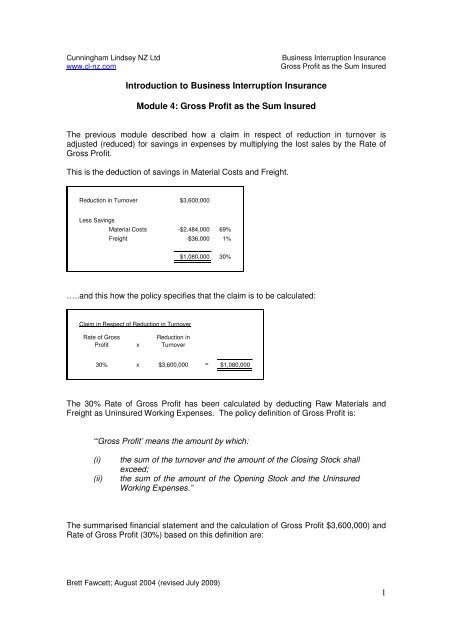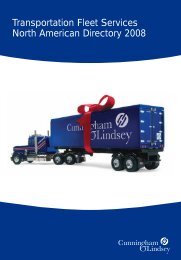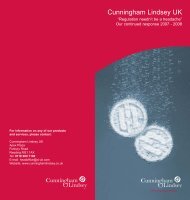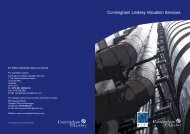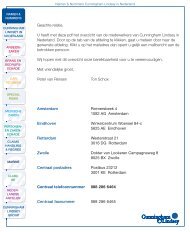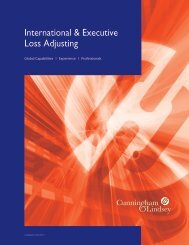Gross Profit as the Sum Insured - Cunningham Lindsey
Gross Profit as the Sum Insured - Cunningham Lindsey
Gross Profit as the Sum Insured - Cunningham Lindsey
Create successful ePaper yourself
Turn your PDF publications into a flip-book with our unique Google optimized e-Paper software.
<strong>Cunningham</strong> <strong>Lindsey</strong> NZ Ltdwww.cl-nz.comBusiness Interruption Insurance<strong>Gross</strong> <strong>Profit</strong> <strong>as</strong> <strong>the</strong> <strong>Sum</strong> <strong>Insured</strong>Introduction to Business Interruption InsuranceModule 4: <strong>Gross</strong> <strong>Profit</strong> <strong>as</strong> <strong>the</strong> <strong>Sum</strong> <strong>Insured</strong>The previous module described how a claim in respect of reduction in turnover isadjusted (reduced) for savings in expenses by multiplying <strong>the</strong> lost sales by <strong>the</strong> Rate of<strong>Gross</strong> <strong>Profit</strong>.This is <strong>the</strong> deduction of savings in Material Costs and Freight.Reduction in Turnover $3,600,000Less SavingsMaterial Costs -$2,484,000 69%Freight -$36,000 1%$1,080,000 30%…..and this how <strong>the</strong> policy specifies that <strong>the</strong> claim is to be calculated:Claim in Respect of Reduction in TurnoverRate of <strong>Gross</strong><strong>Profit</strong>xReduction inTurnover30% x $3,600,000 = $1,080,000The 30% Rate of <strong>Gross</strong> <strong>Profit</strong> h<strong>as</strong> been calculated by deducting Raw Materials andFreight <strong>as</strong> Uninsured Working Expenses. The policy definition of <strong>Gross</strong> <strong>Profit</strong> is:“‘<strong>Gross</strong> <strong>Profit</strong>’ means <strong>the</strong> amount by which:(i)(ii)<strong>the</strong> sum of <strong>the</strong> turnover and <strong>the</strong> amount of <strong>the</strong> Closing Stock shallexceed;<strong>the</strong> sum of <strong>the</strong> amount of <strong>the</strong> Opening Stock and <strong>the</strong> UninsuredWorking Expenses.”The summarised financial statement and <strong>the</strong> calculation of <strong>Gross</strong> <strong>Profit</strong> $3,600,000) andRate of <strong>Gross</strong> <strong>Profit</strong> (30%) b<strong>as</strong>ed on this definition are:Brett Fawcett; August 2004 (revised July 2009)1
<strong>Cunningham</strong> <strong>Lindsey</strong> NZ Ltdwww.cl-nz.comBusiness Interruption Insurance<strong>Gross</strong> <strong>Profit</strong> <strong>as</strong> <strong>the</strong> <strong>Sum</strong> <strong>Insured</strong>Financial Statement<strong>Gross</strong> <strong>Profit</strong> andRate of <strong>Gross</strong> <strong>Profit</strong>Sales $12,000,000 Sales $12,000,000 100%Plus Closing Stock $150,000Cost of Sales Subtotal A $12,150,000Opening Stock $100,000Purch<strong>as</strong>es $8,350,000 Opening Stock $100,000sub-total $8,450,000 Plus Uninsured Working ExpensesLess Closing Stock -$150,000 Purch<strong>as</strong>es $8,350,000Material Costs $8,300,000 Freight $100,000Subtotal B $8,550,000<strong>Gross</strong> <strong>Profit</strong> $3,700,000<strong>Insured</strong> <strong>Gross</strong> <strong>Profit</strong> (A-B) $3,600,000 30%Wages- Manufacturing $2,200,000O<strong>the</strong>r ExpensesDepreciation $250,000Rent $150,000Salaries $500,000Wages - Admin $225,000O<strong>the</strong>r (Incl Freight) $412,000Total O<strong>the</strong>r Expenses $1,537,000Net Operating <strong>Profit</strong>/Loss -$37,000If expenses have been listed <strong>as</strong> Uninsured Working Expenses and deducted from <strong>the</strong>turnover to calculate <strong>Insured</strong> <strong>Gross</strong> <strong>Profit</strong> and <strong>the</strong> Rate of <strong>Gross</strong> <strong>Profit</strong>, <strong>as</strong> we have donewith Material Costs (i.e. Purch<strong>as</strong>es adjusted for opening and closing stock) and Freight,<strong>the</strong>n savings in those expenses are automatically deducted from <strong>the</strong> loss of sales when<strong>the</strong> Rate of <strong>Gross</strong> <strong>Profit</strong> is applied to <strong>the</strong> reduction in turnover. (If this is not clear, Isuggest you go back to look at <strong>the</strong> previous section again.)Uninsured Working Expenses are deductedbecause <strong>the</strong>y are uninsured. The implication isthat <strong>the</strong>y have been saved in proportion to <strong>the</strong> lossof sales.The calculation of claim <strong>as</strong>sumes <strong>the</strong>se expenses have been saved in direct proportionto <strong>the</strong> reduction in turnover. Because <strong>the</strong>re w<strong>as</strong> a 30% loss of sales in our example,30% of <strong>the</strong> Material Costs and 30% of <strong>the</strong> Freight have been allowed for <strong>as</strong> savings.The downside is that <strong>the</strong>y have been deducted, not because <strong>the</strong>y were saved butbecause <strong>the</strong>y were uninsured and it is <strong>the</strong>refore <strong>as</strong>sumed that <strong>the</strong>y have beensaved. The insurers and <strong>the</strong>ir loss adjusters will not even pause to consider whe<strong>the</strong>rBrett Fawcett; August 2004 (revised July 2009)2
<strong>Cunningham</strong> <strong>Lindsey</strong> NZ Ltdwww.cl-nz.comBusiness Interruption Insurance<strong>Gross</strong> <strong>Profit</strong> <strong>as</strong> <strong>the</strong> <strong>Sum</strong> <strong>Insured</strong><strong>the</strong>y have been saved or not. They will simply apply <strong>the</strong> Rate of <strong>Gross</strong> <strong>Profit</strong> <strong>as</strong> <strong>the</strong>policy defines it and <strong>the</strong> result is <strong>the</strong> deduction of Material Costs and Freight.If, say, Freight is not directly variable and <strong>the</strong> savings are less than 30%, <strong>the</strong> calculationspecified in <strong>the</strong> policy will not provide a full indemnity.And so, why run <strong>the</strong> risk? Why not insure all expenses, even Material Costs? In o<strong>the</strong>rwords, why not just insure Turnover?Because, if you insure expenses that are directly variable with sales, <strong>the</strong> sum insured for<strong>Gross</strong> <strong>Profit</strong> will be unnecessarily inflated. This incre<strong>as</strong>es <strong>the</strong> premium. But it doesn’tsimilarly inflate <strong>the</strong> claim because, if <strong>the</strong>re are savings in expenses that have beeninsured, those savings will be deducted from <strong>the</strong> claim. The specification of <strong>the</strong> <strong>Gross</strong><strong>Profit</strong> Item states:“less any sum saved during <strong>the</strong> Indemnity Period in respect of suchcharges and expenses of <strong>the</strong> Business payable out of <strong>Gross</strong> <strong>Profit</strong> <strong>as</strong>may ce<strong>as</strong>e or be reduced in consequence of <strong>the</strong> Damage.”The distinction is that uninsured expenses are deducted whe<strong>the</strong>r <strong>the</strong>y have been savedor not. <strong>Insured</strong> expenses are deducted only if <strong>the</strong>y have been saved.So if Raw Material Costs and Freight have been insured (i.e. There are no UninsuredWorking Expenses.) <strong>the</strong> policy holder will be paying a premium to insure expenses thatare expected to be variable and expected to be saved in direct proportion to a reductionin turnover in <strong>the</strong> event of interruption to <strong>the</strong> business.So why insure <strong>the</strong>m?B<strong>as</strong>ed on <strong>the</strong> accounts we have referred to <strong>as</strong> an example, <strong>the</strong> insured would be payinga premium on $12 million (turnover) instead of on $3.6 million (<strong>Gross</strong> <strong>Profit</strong>).Sales $12,000,000 100%Plus Closing Stock $150,000Subtotal A $12,150,000Opening Stock $100,000Plus Uninsured Working ExpensesPurch<strong>as</strong>es $8,350,000Freight $100,000Subtotal B $8,550,000<strong>Insured</strong> <strong>Gross</strong> <strong>Profit</strong> (A-B) $3,600,000 30%Brett Fawcett; August 2004 (revised July 2009)3
<strong>Cunningham</strong> <strong>Lindsey</strong> NZ Ltdwww.cl-nz.comBusiness Interruption Insurance<strong>Gross</strong> <strong>Profit</strong> <strong>as</strong> <strong>the</strong> <strong>Sum</strong> <strong>Insured</strong>To achieve <strong>the</strong> correct balance between over-insuring and paying unnecessarypremium, on <strong>the</strong> one hand, or under-insuring on <strong>the</strong> o<strong>the</strong>r hand, is not so difficult. Thereis a simple rule:Expenses should be listed <strong>as</strong> uninsured only if <strong>the</strong>y aredirectly variable with turnover or output in all possiblecircumstances of business interruption.You might encounter clients who <strong>as</strong>k of each expense in <strong>the</strong>ir Statement of FinancialPerformance, “Will <strong>the</strong>re be savings in this expense in a major business interruption?”.This is <strong>the</strong> wrong question.They should <strong>as</strong>k, “Is this expense so directly variable that, in <strong>the</strong> event of a small, say10%, loss of sales or output, this expense will also reduce by 10%?”i.e.Is it totally, 100% variable?If it is totally, directly, 100% variable, it does not need to be insured. If <strong>the</strong>re is a 10%loss of sales <strong>the</strong>re will be a 10% saving in this expense and <strong>the</strong> 90% of maintained saleswill be sufficient to recover <strong>the</strong> 90% cost ongoing in respect of this expense.Examples are:Material Costs (i.e. Purch<strong>as</strong>es adjusted for opening and closing stock)Packaging MaterialsFreightSales CommissionsRoyaltiesOutworkIf <strong>the</strong>re were a 10% loss of sales, one would expect a 10% saving in Material Costs,Packaging, Freight, Commissions, Royalties and Outwork. If <strong>the</strong>re were a 35% loss ofsales, one would expect a 35% saving in each of <strong>the</strong>m, and so on.Therefore, to illustrate <strong>the</strong> calculation of <strong>Insured</strong> <strong>Gross</strong> <strong>Profit</strong> and Rate of <strong>Gross</strong> <strong>Profit</strong>set out exactly in accordance with <strong>the</strong> policy, first I will show you again <strong>the</strong> calculation Idid, a moment ago:Brett Fawcett; August 2004 (revised July 2009)4
<strong>Cunningham</strong> <strong>Lindsey</strong> NZ Ltdwww.cl-nz.comBusiness Interruption Insurance<strong>Gross</strong> <strong>Profit</strong> <strong>as</strong> <strong>the</strong> <strong>Sum</strong> <strong>Insured</strong>Sales $12,000,000 100%Plus Closing Stock $150,000Subtotal A $12,150,000Opening Stock $100,000Plus Uninsured Working ExpensesPurch<strong>as</strong>es $8,350,000Freight $100,000Subtotal B $8,550,000<strong>Insured</strong> <strong>Gross</strong> <strong>Profit</strong> (A-B) $3,600,000 30%Subject to <strong>the</strong> necessary allowance for trends of <strong>the</strong> business that I will describe later,<strong>the</strong> sum insured for <strong>Insured</strong> <strong>Gross</strong> <strong>Profit</strong> should be $3.6 million and <strong>the</strong> Rate of <strong>Gross</strong><strong>Profit</strong> used in a claim would be 30%.Before leaving <strong>Insured</strong> <strong>Gross</strong> <strong>Profit</strong> and <strong>the</strong> Rate of <strong>Gross</strong> <strong>Profit</strong> I must elaborate onsomething I said and p<strong>as</strong>sed over quickly.I said that, “If <strong>the</strong>re is a 35% loss of sales, one would expect a 35% saving in Materialsand Freight”.I deliberately stated this in an equivocal manner. I could have said “There will be <strong>as</strong>aving ….” But I said, “One would expect.”I expressed myself this way because I would expect Materials and Freight to be totallyvariable expenses, which do not need to be insured. I would also expect Commissions,Discounts, Outwork, Bad Debts, Duty, Packaging and Royalties, to be directly variableand <strong>the</strong>refore uninsured.However, you must discuss <strong>the</strong> nature of each expense with your client because <strong>the</strong>reare circumstances and cost structures in which any one of <strong>the</strong>m might not be totallyvariable.I <strong>the</strong>refore make a small fine-tuning adjustment to <strong>the</strong> rule about which expenses toinsure and which to list <strong>as</strong> uninsured.Expenses should be listed <strong>as</strong> uninsured onlyif, in <strong>the</strong> context of a particular client’sbusiness and cost structure <strong>the</strong>y aredirectly variable with turnover or output in allpossible circumstances of businessinterruption.Brett Fawcett; August 2004 (revised July 2009)5
<strong>Cunningham</strong> <strong>Lindsey</strong> NZ Ltdwww.cl-nz.comBusiness Interruption Insurance<strong>Gross</strong> <strong>Profit</strong> <strong>as</strong> <strong>the</strong> <strong>Sum</strong> <strong>Insured</strong>If this all gets too complicated for your client or <strong>the</strong> client is reluctant to give you detailsof its financial performance <strong>the</strong>re is a simple short cut solution. Ask for sales andpurch<strong>as</strong>es. <strong>Insured</strong> <strong>Gross</strong> <strong>Profit</strong> is approximately Sales less Purch<strong>as</strong>es.Sales $12,000,000less Purch<strong>as</strong>es $8,350,000<strong>Insured</strong> <strong>Gross</strong> <strong>Profit</strong> $3,650,000Which compares with <strong>the</strong> more correct and detailed calculation <strong>as</strong> follows:Sales $12,000,000Plus Closing Stock $150,000Subtotal A $12,150,000Opening Stock $100,000Plus Uninsured Working ExpensesPurch<strong>as</strong>es $8,350,000Freight $100,000Subtotal B $8,550,000<strong>Insured</strong> <strong>Gross</strong> <strong>Profit</strong> (A-B) $3,600,000Is it worth <strong>the</strong> bo<strong>the</strong>r to do it correctly?Well, I would have to conclude from this example that it is not. However, if <strong>the</strong>re aresignificant expenses in addition to Purch<strong>as</strong>es that are directly variable, <strong>the</strong> fact that <strong>the</strong>yare not listed <strong>as</strong> uninsured could result in a degree of over-insurance.If closing stock were substantially greater than opening stock this shortcut could result inunder-insurance. But this potential pitfall can be avoided by <strong>as</strong>king whe<strong>the</strong>r any materialincre<strong>as</strong>e or decre<strong>as</strong>e in stock between opening and closing stock is shown in <strong>the</strong>accounts. The amount of an incre<strong>as</strong>e in stock should be added to <strong>the</strong> <strong>Insured</strong> <strong>Gross</strong><strong>Profit</strong> and a decre<strong>as</strong>e should be deducted from <strong>the</strong> <strong>Insured</strong> <strong>Gross</strong> <strong>Profit</strong>.Alternatively, <strong>as</strong>k for Turnover and Material Costs. Because Material Costs comprisePurch<strong>as</strong>es adjusted for opening and closing stock no fur<strong>the</strong>r allowance is needed forstock incre<strong>as</strong>e or decre<strong>as</strong>e.Brett Fawcett; August 2004 (revised July 2009)6
<strong>Cunningham</strong> <strong>Lindsey</strong> NZ Ltdwww.cl-nz.comBusiness Interruption Insurance<strong>Gross</strong> <strong>Profit</strong> <strong>as</strong> <strong>the</strong> <strong>Sum</strong> <strong>Insured</strong>Before continuing, let’s recap what we have learned about <strong>Gross</strong> <strong>Profit</strong> in this module.Review1 <strong>Gross</strong> <strong>Profit</strong> is used <strong>as</strong> <strong>the</strong> sum insured for <strong>the</strong> b<strong>as</strong>ic policyitem in business interruption insurance.2 <strong>Insured</strong> <strong>Gross</strong> <strong>Profit</strong> can be calculated from a Statement ofFinancial Performance, simply by taking Sales minusPurch<strong>as</strong>es.3 But this is inaccurate if <strong>the</strong>re h<strong>as</strong> been a significant differencebetween opening and closing stock and/or if <strong>the</strong>re are o<strong>the</strong>rexpenses that are directly variable with turnover orproduction.4 If <strong>the</strong> calculation of <strong>Insured</strong> <strong>Gross</strong> <strong>Profit</strong> is to be donecorrectly, it is:Turnover plus closing stockLess opening stock, purch<strong>as</strong>es and o<strong>the</strong>r uninsuredexpenses5 Uninsured expenses are only those that are directly variable in<strong>the</strong> circumstances of a particular client’s business.6 By multiplying <strong>the</strong> loss of sales by <strong>the</strong> Rate of <strong>Gross</strong> <strong>Profit</strong> <strong>the</strong>claim for loss of sales is adjusted for savings in <strong>the</strong> UninsuredWorking Expenses.7 The loss adjuster does not need to identify that <strong>the</strong>re wereactual savings in <strong>the</strong>se expenses. Because <strong>the</strong>y are uninsured<strong>the</strong> claim <strong>as</strong>sumes <strong>the</strong>y will have been saved in directproportion to <strong>the</strong> loss of sales.Brett Fawcett; August 2004 (revised July 2009)7
<strong>Cunningham</strong> <strong>Lindsey</strong> NZ Ltdwww.cl-nz.comBusiness Interruption Insurance<strong>Gross</strong> <strong>Profit</strong> <strong>as</strong> <strong>the</strong> <strong>Sum</strong> <strong>Insured</strong>Insuring Future <strong>Gross</strong> <strong>Profit</strong>I will add two comments before we leave <strong>the</strong> subject of <strong>Insured</strong> <strong>Gross</strong> <strong>Profit</strong>.Business Interruption policies do notinsure historical profit.They insure future profit.Therefore <strong>the</strong> <strong>Gross</strong> <strong>Profit</strong> calculated from <strong>the</strong> Statement of Financial Performance mustbe adjusted for growth trends and special circumstances so that <strong>the</strong> sum insured is <strong>the</strong>best possible estimate of <strong>the</strong> <strong>Insured</strong> <strong>Gross</strong> <strong>Profit</strong> that <strong>the</strong> client expects to achieve in<strong>the</strong> future; actually projected <strong>as</strong> far <strong>as</strong> <strong>the</strong> year after <strong>the</strong> end of <strong>the</strong> insurance period.For example, <strong>the</strong> <strong>Insured</strong> <strong>Gross</strong> <strong>Profit</strong> that we have calculated at $3.6 million might havebeen b<strong>as</strong>ed on <strong>the</strong> financial year ended 31 March 2004.We might be dealing with a client whose insurance period goes from 1 September 2004to 1 September 2005.But if major damage occurred on 31 August 2005, which interrupted <strong>the</strong> business over<strong>the</strong> next 12 months, (i.e. to 31 August 2006) <strong>the</strong> sum insured from 1 September 2004must be adequate for this future Indemnity Period.The year ended 31 August 2006 is two and a half years on from <strong>the</strong> financial year onwhich <strong>the</strong> $3.6 million is calculated. Compounding growth rates of, say, 10% couldrequire <strong>the</strong> figure to be incre<strong>as</strong>ed to $4,537,500, an incre<strong>as</strong>e of nearly $1 million.Brett Fawcett; August 2004 (revised July 2009)8
<strong>Cunningham</strong> <strong>Lindsey</strong> NZ Ltdwww.cl-nz.comBusiness Interruption Insurance<strong>Gross</strong> <strong>Profit</strong> <strong>as</strong> <strong>the</strong> <strong>Sum</strong> <strong>Insured</strong><strong>Insured</strong> <strong>Gross</strong> <strong>Profit</strong>b<strong>as</strong>ed on accounts for y/e 31 March 2004 $3,600,000plus 10% pa for 5 months to 1 September 2004 $150,000(i.e. to start of Insurance Period)Subtotal $3,750,000plus 10% pa to 1 September 2005 $375,000(i.e. to end of Insurance Period)Subtotal $4,125,000plus 10% pa to 31 August 2006 $412,500(i.e. end of <strong>the</strong> most distant possible 12 month indemnityperiod should damage occur at <strong>the</strong> end of <strong>the</strong> InsurancePeriod, say 31 August 2004)<strong>Sum</strong> <strong>Insured</strong> $4,537,500The sum insured for <strong>Insured</strong> <strong>Gross</strong> <strong>Profit</strong> must be adequate to cover <strong>the</strong> maximumpossible loss and adequate to avoid <strong>the</strong> application of average. This calculation satisfiesboth criteria.The second of our two final points about <strong>Insured</strong> <strong>Gross</strong> <strong>Profit</strong> is <strong>the</strong> Indemnity Period,which also impacts <strong>the</strong> sum insured.BI policies insure <strong>the</strong> loss of profit for a limited period; say a maximum of 12 or 18months. This maximum is <strong>the</strong> Indemnity Period selected by <strong>the</strong> insured and stated in<strong>the</strong> Schedule of <strong>the</strong> policy. We have seen it referred to in <strong>the</strong> specification of <strong>the</strong> <strong>Gross</strong><strong>Profit</strong> Item and in <strong>the</strong> definition of historical Standard Turnover.Up to this point all <strong>the</strong> calculations of <strong>Gross</strong> <strong>Profit</strong> are b<strong>as</strong>ed on a set of accounts, whichwe <strong>as</strong>sumed to be for a full financial year and <strong>the</strong> calculation of an appropriate suminsured for <strong>Gross</strong> <strong>Profit</strong> is also an annual figure. This is correct unless <strong>the</strong> maximumIndemnity Period stated in <strong>the</strong> policy is in excess of twelve months, in which c<strong>as</strong>e <strong>the</strong>sum insured needs to be a proportionate multiple of annual <strong>Gross</strong> <strong>Profit</strong>, e.g. 150% foran 18 month Indemnity Period.For maximum indemnity periods in excess of 12 months <strong>the</strong>sum insured must be a proportionate multiple of <strong>the</strong> annual<strong>Gross</strong> <strong>Profit</strong>Brett Fawcett; August 2004 (revised July 2009)9
<strong>Cunningham</strong> <strong>Lindsey</strong> NZ Ltdwww.cl-nz.comBusiness Interruption Insurance<strong>Gross</strong> <strong>Profit</strong> <strong>as</strong> <strong>the</strong> <strong>Sum</strong> <strong>Insured</strong>The full calculation for an 18 month maximum Indemnity Period is:<strong>Insured</strong> <strong>Gross</strong> <strong>Profit</strong>b<strong>as</strong>ed on accounts for y/e 31 March 2004 $3,600,000plus 10% pa for 5 months to 1 September 2004 $150,000(i.e. to start of Insurance Period)Subtotal $3,750,000plus 10% pa to 1 September 2005 $375,000(i.e. to end of Insurance Period)Subtotal $4,125,000plus 10% pa to 31 August 2006 $412,500(i.e. end of <strong>the</strong> most distant possible 12 month indemnityperiod should damage occur at <strong>the</strong> end of <strong>the</strong> InsurancePeriod, say 31 August 2004)Subtotal $4,537,500Multiple for an 18 month Indemnity Period 150%Appropriate <strong>Sum</strong> <strong>Insured</strong> $6,806,250I h<strong>as</strong>ten to state that although <strong>the</strong> sum insured is multiplied proportionately for IndemnityPeriods in excess of 12 months it is not reduced for lesser Indemnity Periods. A sixmonthIndemnity Period should still have annual <strong>Insured</strong> <strong>Gross</strong> <strong>Profit</strong> <strong>as</strong> <strong>the</strong> suminsured.This annual <strong>Gross</strong> <strong>Profit</strong> will be larger than <strong>the</strong> maximum possible BI claim in a sixmonthmaximum Indemnity Period in all but extremely highly se<strong>as</strong>onal businesses.However, irrespective of whe<strong>the</strong>r <strong>the</strong>re is an average condition in <strong>the</strong> policy, it is likelythat <strong>the</strong> figure for <strong>the</strong> sum insured in <strong>the</strong> proposal is stated to be annual <strong>Gross</strong> <strong>Profit</strong> inwhich c<strong>as</strong>e a six-month figure might be construed <strong>as</strong> material misrepresentation of <strong>the</strong>value at risk.Brett Fawcett; August 2004 (revised July 2009)10
<strong>Cunningham</strong> <strong>Lindsey</strong> NZ Ltdwww.cl-nz.comBusiness Interruption Insurance<strong>Gross</strong> <strong>Profit</strong> <strong>as</strong> <strong>the</strong> <strong>Sum</strong> <strong>Insured</strong>Review1 The sum insured must be adequate to cover <strong>the</strong>maximum possible loss and to avoid <strong>the</strong> possibility ofaverage.2 The sum insured must be <strong>the</strong> best possible projectionof <strong>Gross</strong> <strong>Profit</strong> for <strong>the</strong> 12 months p<strong>as</strong>t <strong>the</strong> end of <strong>the</strong>current insurance period.3 For maximum Indemnity Periods in excess of 12months a multiple of annual <strong>Gross</strong> <strong>Profit</strong> must be used<strong>as</strong> <strong>the</strong> sum insuredBecause average is not usually a feature of BI policies in New Zealand I don’t intend toaddress it at this stage. It will be covered in a later module. The <strong>as</strong>sessment ofmaximum possible losses from a BI perspective will be <strong>the</strong> subject of a separate article.Brett FawcettAugust 2004Brett Fawcett; August 2004 (revised July 2009)11


